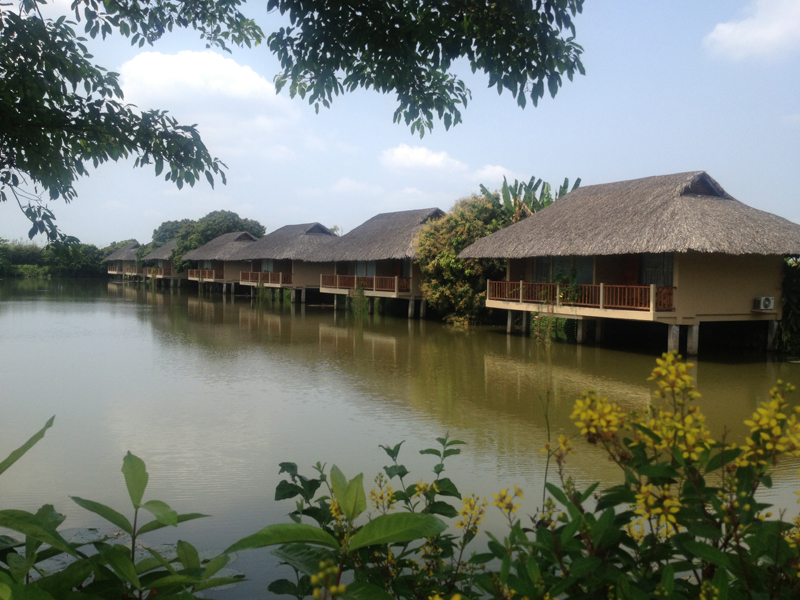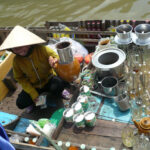Main Info
The Mekong Discovery Tour takes you to the unique places of Mekong. You can experience the lifestyle of the local people on the river with their floating market, fish farm. Try green tea with honey and learn how they collect honey from their bee gardens.
| Departure place | We pick you up from your hotel |
| Departure Time | Scheduled time |
| Tour code | VRT – 06 |
| Tour duration | 4 days 3 nights |
| Tour type | Private |
| Included |
|
| Excluded |
|
TOUR COST per Person (in US $)
All inclusive in Twin or Double Room / Meal (Daily Breakfast and Lunch)
| 2 pax | 4 pax | 6 pax | 8 pax | 10 pax | Single Supplemental | |
| Budget | 510 | 480 | 410 | 380 | 350 | 75 |
| Superior | 650 | 600 | 570 | 530 | 490 | 125 |
| Deluxe | 780 | 730 | 690 | 650 | 600 | 330 |
Children Policy:
Child under 2 years old : No additional charge
Child from 2 to less than 5 years old: Charge 50%
Child from 5 to less than 10 years old: Charge 75%
Child from 10 years old and up: Adult’s rate
Note:
• All rates are in USD and per person
• The rate may be changed without prior notice if there is a market fluctuation relating petrol, food and goods or ticket price
• Surcharge will be added on Public Holiday and Peak Season
Itinerary
Day 01: Saigon - My Tho
7.00 am: we will pick you up from your hotel.
After a short drive along the provincial roads on the Southern region of Vietnam through paddy rice-fields, pine-apple plantation, orchard and small hamlets we will get to My Tho.
My Tho is the capital city and municipality of the Tien Giang Province in the Mekong Delta region of southern Vietnam. It has a population of approximately 160,000.
As the regional capital, My Tho is the main market dealing in all the produce from the region as well as fish & seafood from My Tho's large ocean going fishing fleet. The very large & exuberant market is one of South Vietnam's biggest sources for dried fish & other dried seafood products such as Kho Muc - dried squid. At nighttime the market is dedicated to the dealing & sorting of Mekong river fish -particularly catfish for HCMC's wholesale markets. Produce especially fruit & vegetable is delivered by boat directly to the market.
We will start our trip to discover the Mekong Delta by taking a boat across the river to visit some islands of Dragon, Unicorn, Phoenix and Turtle. A chance for you to view floating fish farms, fleet of fishing boats, stilt houses and boat building factory. We will have lunch on board before getting off the boat to visit coconut candy maker’s, have a walk through fruit gardens, then take a horse-drawn cart along the country road to visit a local house, where you will experience the way of bee-keeping. You will enjoy the local fruits from the garden, drinking green tea with honey while listening to the typical Vietnamese music. Then we will take the rowing through canals, coconut palm gardens to our boat. We will go back to the habour where the cyclos await to take us around My Tho Town.
We stay over night at the hotel by the river.
Day 02: My Tho - Cai Be
In the morning we make a private boat trip on the Upper Mekong to Cai Be. It is a great chance for you to experience the real daily life of the local people living along the river. We get to Cai Be about noon. After checking - into our bungalows at the Mekong Lodge Resort (an eco-tourist resort was built stretching along the Tien River, the natural harmony, where the fresh air, natural surroundings and fresh, mild rivers, to meet the needs rest nutrition, recreation, sightseeing tour of travelers). we have lunch served in the nice restaurant with the special day-menu and relax.
- Afternoon walking or biking visit to the home's factories of Candy and handicraft near by the village
- Late afternoon participating in cooking class and having dinner with what you’ve cooked
- Riverside Bar are open until mid-night.
- Buffet breakfast in the restaurant
- Walking or cycling tour around the island
- Go to one of the orchard, free fruits picking of mango, rambutan,
longan…
- Boat transfer to Cai be harbor and catch your bus again to Xeo Quyet
Xeo Quyet
Location: It belongs to two Communes of My Hiep and My Long, Cao Lanh District, Dong Thap Province.
Characteristics: A revolutionary base during the anti-French and US resistance wars, the 20ha cajeput forest of present-day Xeo Quyt has been reclaimed and become an attractive historical and ecological tourist site in the southern delta.
To visit the boundless watery cajeput forest in the Plain of Reeds by boat is really an interesting excursion. Boating in the cajeput forest of Xeo Quyt requires a lot of skill. To move forward, the boat glides between cajeput trees, whose roots are rough and covered with a brown and thin multi-layer skin. The air is cool and humid and has the fragrance of the cajeput flowers and latex. Now and then, a bird singing or fish splashing produces a sudden sound that echoes amid the quiet environment.
The forest looks like a floating painting. Around it, climbing plants grow along the cajeput trees and brighten under the sunlight. All bring about an atmosphere of a nature full of vitality and wildness. Xeo Quyt reminds visitors of the former vast cajeput forests in the Plains of Reeds and U Minh areas. Although being heavily devastated during the war, in 1975 by the end of the war, more than 100,000ha of submerged forests remained, covering parts of Long An, An Giang, Kien Giang, Bac Lieu and Ca Mau provinces and producing a wonderful ecological system of the alluvial land at the Mekong River's estuary. The cajeput forests work as a great water reservoir to fight against salt water and acidity and regulate the humidity during the dry season. During the war, they were ideal destinations for the liberation army men. The crisscrossing canals, built in the early 20th century, became transportation routes and enabled the local people to reclaim land, develop forestry and prevent fire. At the time, the so-called "socio-cultural and economic cajeput forest development" was encouraged and it is linked with the national history of land reclaiming and defence.
The cajeput forests, submerged in the red brown water, are an ideal habitation for numerous kinds of birds, fish and wild animals, typical for the tropical region. The cajeput timber, due to its flexibility and resistance to rotting, are often used in house building and basement floors. Xeo Quyt, a small part in the vast cajeput forests, was a successful undertaking to restore and preserve the cajeput forests to their original historical and ecological background. Further preservation will be considered and implemented. But more importantly, effort should be made by everyone to protect the unique ecological system of the entire submerged area, whose history has developed along with land reclaiming and defending of the fertile southern region.
We have lunch at one of some gorgious restaurants in Xeo Quyet then rejoin the bus to Long Xuyen.
Long Xuyen
Is the capital city of An Giang Province, in the Mekong Delta region of southwestern Vietnam. It is located at approximately 1,950 km south of Hanoi, 189 km from Ho Chi Minh City, and 45 km from the boundary with Cambodia. The population of Long Xuyen city is over 300,000 (2007), with an area of only 130 km².
Long Xuyen is the second most prosperous city in southwestern Vietnam, just after Can Tho city
Long Xuyen is a very developed city in merchandising (mainly in rice trading) and processing fish industry (such as basa fish) with more than six plants and 10,000 workers.
Check-in our hotel and stay over night here in Long Xuyen.
In the morning we make a cycling trip through the town, countryside and visit local market then go back to Saigon by bus.
We drop you off at your hotel in Saigon and say goodbye.














